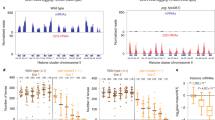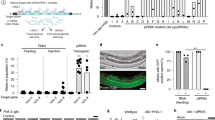Abstract
Epigenetic information is frequently erased near the start of each new generation1. In some cases, however, epigenetic information can be transmitted from parent to progeny (multigenerational epigenetic inheritance)2. A particularly notable example of this type of epigenetic inheritance is double-stranded RNA-mediated gene silencing in Caenorhabditis elegans. This RNA-mediated interference (RNAi) can be inherited for more than five generations3,4,5,6,7,8. To understand this process, here we conduct a genetic screen for nematodes defective in transmitting RNAi silencing signals to future generations. This screen identified the heritable RNAi defective 1 (hrde-1) gene. hrde-1 encodes an Argonaute protein that associates with small interfering RNAs in the germ cells of progeny of animals exposed to double-stranded RNA. In the nuclei of these germ cells, HRDE-1 engages the nuclear RNAi defective pathway to direct the trimethylation of histone H3 at Lys 9 (H3K9me3) at RNAi-targeted genomic loci and promote RNAi inheritance. Under normal growth conditions, HRDE-1 associates with endogenously expressed short interfering RNAs, which direct nuclear gene silencing in germ cells. In hrde-1- or nuclear RNAi-deficient animals, germline silencing is lost over generational time. Concurrently, these animals exhibit steadily worsening defects in gamete formation and function that ultimately lead to sterility. These results establish that the Argonaute protein HRDE-1 directs gene-silencing events in germ-cell nuclei that drive multigenerational RNAi inheritance and promote immortality of the germ-cell lineage. We propose that C. elegans use the RNAi inheritance machinery to transmit epigenetic information, accrued by past generations, into future generations to regulate important biological processes.
This is a preview of subscription content, access via your institution
Access options
Subscribe to this journal
Receive 51 print issues and online access
$199.00 per year
only $3.90 per issue
Buy this article
- Purchase on Springer Link
- Instant access to full article PDF
Prices may be subject to local taxes which are calculated during checkout




Similar content being viewed by others
References
Reik, W., Dean, W. & Walter, J. Epigenetic reprogramming in mammalian development. Science 293, 1089–1093 (2001)
Jablonka, E. & Raz, G. Transgenerational epigenetic inheritance: prevalence, mechanisms, and implications for the study of heredity and evolution. Q. Rev. Biol. 84, 131–176 (2009)
Fire, A. et al. Potent and specific genetic interference by double-stranded RNA in Caenorhabditis elegans. Nature 391, 806–811 (1998)
Grishok, A., Tabara, H. & Mello, C. C. Genetic requirements for inheritance of RNAi in C. elegans. Science 287, 2494–2497 (2000)
Vastenhouw, N. L. et al. Gene expression: long-term gene silencing by RNAi. Nature 442, 882 (2006)
Alcazar, R. M., Lin, R. & Fire, A. Z. Transmission dynamics of heritable silencing induced by double-stranded RNA in Caenorhabditis elegans. Genetics 180, 1275–1288 (2008)
Burton, N. O., Burkhart, K. B. & Kennedy, S. Nuclear RNAi maintains heritable gene silencing in Caenorhabditis elegans. Proc. Natl Acad. Sci. USA 108, 19683–19688 (2011)
Gu, S. G., Pak, J., Guang, S., Maniar, J. M., Kennedy, S. & Fire, A. Amplification of siRNA in Caenorhabditis elegans generates a transgenerational sequence-targeted histone H3 lysine 9 methylation footprint. Nature Genet. 44, 157–164 (2012)
Yigit, E. et al. Analysis of the C. elegans Argonaute family reveals that distinct Argonautes act sequentially during RNAi. Cell 127, 747–757 (2006)
Gu, W. et al. Distinct argonaute-mediated 22G-RNA pathways direct genome surveillance in the C. elegans germline. Mol. Cell 36, 231–244 (2009)
Guang, S. et al. An Argonaute transports siRNAs from the cytoplasm to the nucleus. Science 321, 537–541 (2008)
Guang, S. et al. Small regulatory RNAs inhibit RNA polymerase II during the elongation phase of transcription. Nature 465, 1097–1101 (2010)
Burkhart, K. B. et al. A pre-mRNA-associating factor links endogenous siRNAs to chromatin regulation. PLoS Genet. 7, e1002249 (2011)
Beanan, M. J. & Strome, S. Characterization of a germ-line proliferation mutation in C. elegans. Development 116, 755–766 (1992)
Pak, J. & Fire, A. Distinct populations of primary and secondary effectors during RNAi in C. elegans. Science 315, 241–244 (2007)
Ahmed, S. & Hodgkin, J. MRT-2 checkpoint protein is required for germline immortality and telomere replication in C. elegans. Nature 403, 159–164 (2000)
Tabara, H. et al. The rde-1 gene, RNA interference, and transposon silencing in C. elegans. Cell 99, 123–132 (1999)
Tabara, H., Yigit, E., Siomi, H. & Mello, C. C. The dsRNA binding protein RDE-4 interacts with RDE-1, DCR-1, and a DExH-box helicase to direct RNAi in C. elegans. Cell 109, 861–871 (2002)
Bagijn, M. P. et al. Function, targets, and evolution of Caenorhabditis elegans piRNAs. Science http://dx.doi.org/10.1126/science.1220952 (4 June 2012)
Ashe, A. et al. piRNAs can trigger a multigenerational epigenetic memory in the germline of C. elegans.. Cell 150, 88–99 (2012)
Shirayama, M. et al. piRNAs initiate an epigenetic memory of nonself RNA in the C. elegans germline. Cell 150, 65–77 (2012)
Acknowledgements
We thank P. Anderson, H. Opalicious and D. Wassarman for discussions. We thank S. Ahmed and members of the Ahmed laboratory for sharing unpublished data concerning the role of nrde-1 in germline immortality. This work was supported by grants from the Pew and Shaw scholar’s programs, and the National Institutes of Health, GM88289 (S.K.), GM37706 (A.F.) and GM069454 (J.K).
Author information
Authors and Affiliations
Contributions
B.B. contributed to Figs 1a–c, 2b–d and Supplementary Figs 3, 4, 5b, 6, 8, 10 and 13. K.B. contributed to Figs 2c, 3d–f, 4a, b and Supplementary Figs 13–15, 16a–c, 17, 18 and 19c. S.G.G. and A.F. contributed to Fig. 3a–c, Supplementary Table 2 and Supplementary Figs 11 and 12. G.S. contributed to Supplementary Figs 2, 5a and 16d. A.K. and J.K contributed to Fig. 4b and Supplementary Figs 7 and 19a. H.F. contributed to Fig. 4a and Supplementary Figs 16a–c, 17, 18 and 19c. S.K. contributed to Figs 1a–d, 2a, 3b, Supplementary Table 1 and Supplementary Figs 2, 6b, 9, 10b and 19b. S.K., B.B. and K.B. wrote the manuscript.
Corresponding author
Ethics declarations
Competing interests
The authors declare no competing financial interests.
Supplementary information
Supplementary Information
This file contains a Supplementary Discussion, Supplementary Tables 1-2 (see separate zipped excel file for Supplementary Table 2), Supplementary Figures 1-19, Supplementary Material and Methods and additional references. (PDF 8332 kb)
Supplementary Tables
This zipped file contains Supplementary Table 2. (ZIP 614 kb)
Rights and permissions
About this article
Cite this article
Buckley, B., Burkhart, K., Gu, S. et al. A nuclear Argonaute promotes multigenerational epigenetic inheritance and germline immortality. Nature 489, 447–451 (2012). https://doi.org/10.1038/nature11352
Received:
Accepted:
Published:
Issue Date:
DOI: https://doi.org/10.1038/nature11352
This article is cited by
-
HRDE-2 drives small RNA specificity for the nuclear Argonaute protein HRDE-1
Nature Communications (2024)
-
Selfish conflict underlies RNA-mediated parent-of-origin effects
Nature (2024)
-
The histone chaperone SPT2 regulates chromatin structure and function in Metazoa
Nature Structural & Molecular Biology (2024)
-
Maternal patterns of inheritance alter transcript expression in eggs
BMC Genomics (2023)
-
Tubular lysosome induction couples animal starvation to healthy aging
Nature Aging (2023)
Comments
By submitting a comment you agree to abide by our Terms and Community Guidelines. If you find something abusive or that does not comply with our terms or guidelines please flag it as inappropriate.



